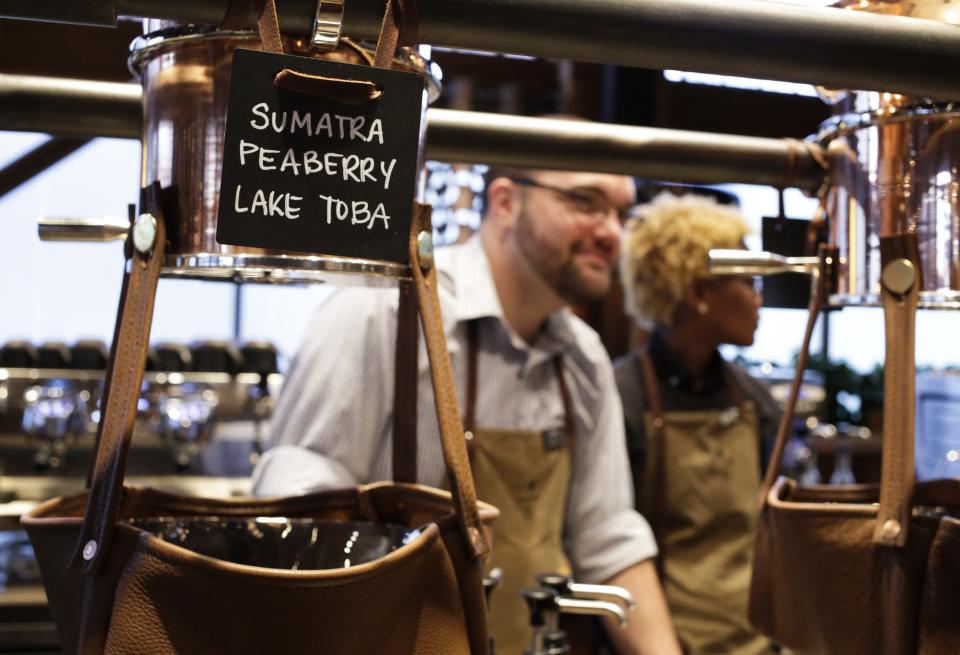How Starbucks aims to woo coffee snobs back to the brand
Howard Schultz is giving up his post as CEO of Starbucks, effective in April, the coffee chain announced last week. In his new role as chairman, he will steer the company’s ambitious move into high-end coffee bars. Starbucks will open 1,000 new “Reserve” stores across the globe, plus 30 “Reserve Roastery” rooms. It will also install Reserve bars in 20% of its existing stores.
There is an irony to all of this.
Starbucks was once seen as the fancy, upscale disruptor in the coffee business. Now, with 25,000 stores around the world, it’s become mainstream, and fell behind in the ultra-high-end coffee game, which has included small “third wave” coffee operations like Blue Bottle (Silicon Valley), Stumptown (Portland) and Intelligentsia (Chicago).
Now Starbucks is scrambling to adapt. “The Roastery is the beginning,” said Schultz at the company’s investor day on Wednesday, “of building a premium brand, the Starbucks Reserve brand, inside the Starbucks corporation.”
Translation: Reserve and Reserve Roastery are an aggressive effort to court the hipster coffee aficionados that have flocked to small boutique chains for a cup made by hand, by a “real” barista, in the method of the discerning customer’s choosing.
But can Starbucks, now seen as the corporate giant in the coffee world, win them over?

“Starbucks is the millennials’ parents’ coffee house,” Ric Rhinehart, executive director of the Specialty Coffee Association of America, told Reuters. It is a quote that perfectly reflects just how much has changed since Starbucks opened its first little store in Seattle in 1971.
It took 46 years for Starbucks to open stores in Italy. The company announced in February that it will open its first shop there next year. It famously waited so long out of respect (and intimidation) for the Italian coffee market. Schultz visited Milan in 1983, when he was just a marketing director for Starbucks and the chain only had four stores, and was inspired by what he saw. When Starbucks finally announced it would dip its toes into Italy, Schultz told the New York Times, “There are very few markets and stores that I’m as intimately involved in as this.”
This is the company’s next bold chess move, so it makes sense Schultz will again head up the effort. As with everything it tries, Starbucks isn’t moving gingerly: 1,000 new Reserve stores is hardly a subtle step. Starbucks will have pricing power at these stores (think $10 lattes hand-poured through beautiful glass siphons and accessories) but there’s no guarantee that moneyed millennials who have caught the coffee bug are ready to double their spending per cup (competitors like Blue Bottle charge $4.50 for a latte).
Once Starbucks opens up 1,000 more Reserve stores and adds Reserve bars to 20% of its current fleet, it will have 6,000 Reserve locations worldwide, which means that even the small super-high-end slice of the $85 billion-market-cap company will dwarf the entire footprint of the competitors it’s taking on. It could prove to be too many fancy new stores at once, or, if successful, it could spell trouble for the small guys.
By comparison, Blue Bottle has 29 stores (six in Tokyo), Stumptown has 12, and Intelligentsia has 10. Most of those 51 shop locations are in California, Seattle and Portland, Ore.—not New York, which is so flooded with coffee shops that in October, Coffee Bean & Tea Leaf, a West Coast chain with more than 1,000 stores, abruptly closed all 12 of its New York locations.
Starbucks opened up a Reserve bar inside four New York City locations this year, but the focus of its premium blitz is not New York. It has an eye trained on China, its fastest growing market and where the coffee business is growing at 15% per year. “We think China someday will be bigger than US in the number of stores we have,” Starbucks CFO Scott Maw tells Yahoo Finance.
Starbucks has repeatedly shown that it cares about following trends.
Last year it added cold brew coffee, which has been embraced by the likes of Peet’s, Dunkin’ Donuts, Le Pain Quotidien, and even Chick-fil-A. (Even McDonald’s will now “third-wavify” the coffee at its upscale McCafé stores.)
And it has made food a bigger part of its business: Reserve stores and Roasteries will serve beer and wine, and even fancy snacks (and pizza) from Princi, an Italian bakery in which Starbucks invested. Food now represents 20% of Starbucks’ US retail sales.
The new premium-store blitz is Starbucks going small (“Our rarest coffees, small-batch roasted in Seattle,” it touts on the Reserve web site) but also betting on a healthy economy. The company is opening these 1,000 Reserve stores (and 12,000 new stores in the next five years) despite Schultz’s opinion that, “We’re going to see a very major downturn in the fact that the country is over-retailed in lots of categories.”
Some of the stores may even end up losing money, but this is as much about brand and image than anything else—not unlike brick-and-mortar retailers opening fancy “flagship” stores on Manhattan’s Fifth Avenue.
It’s about reminding coffee snobs that big, bad Starbucks can still go small and hand-crafted.
—
Daniel Roberts is a writer at Yahoo Finance, covering sports business and technology. Follow him on Twitter at @readDanwrite.
Read more:
Why so many brands are opening fancy flagship stores in NYC
